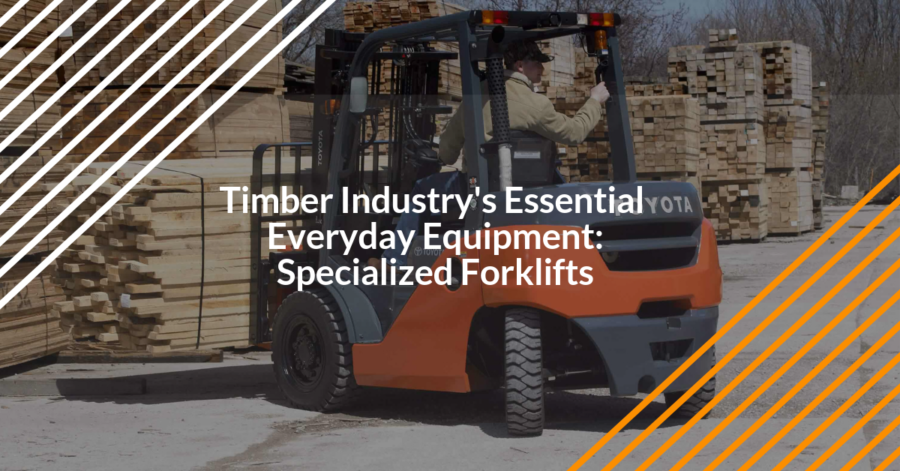Latest Trends in the Lumber and Wood Industry
 The process of getting timber from its raw, untreated form to a finished product is filled with plenty of good old fashioned sweat, hard labor, chemicals, transportation, logistics, warehousing and plenty of other steps along the way.
The process of getting timber from its raw, untreated form to a finished product is filled with plenty of good old fashioned sweat, hard labor, chemicals, transportation, logistics, warehousing and plenty of other steps along the way.
Without specialized forklifts to help manage all the cargo involved with lumber production – trees, boxes, supplies, pallets, and more – the timber industry would be at a standstill. Thanks to the hard work, careful planning and safe work practices demonstrated by American workers on lumber forklifts, everything from the construction industry to furniture production and more continues apace.
In the past few years, a few surprising trends have taken the lumber and wood industry to new heights – literally, in terms of commodity price. In fact, the price of lumber and plywood has doubled in some regional U.S. markets!
To put it another way, about the only things more important than forklifts to the timber industry are…trees!
Here’s another important element of forklift in the timber and lumber industry: training. ForkliftCertification.com, the leader in online U.S. Occupational Safety and Health Administration (OSHA) approved safety training, offers unmatched knowledge, convenient anytime access, and lifetime support for all of your compliance needs. OSHA requires that every U.S. employer – including lumber companies, big box retailers, and every other facility involved in the timber industry – offer their workers complete safety training.
If you’re in the lumber and wood industry FLC has everything you need to become OSHA compliant. Our safety courses explain basic safety concepts for lumber forklift operators and other powered industrial trucks. So whatever industry you’re in, we’re the affordable, accurate, only training solution you need. Sign up today!
OK, let’s quickly look at how trees in the forest become finished lumber, then look at some trends in the lumber and wood industry worth paying attention to.
How Trees Become Finished Lumber: A Basic Primer
 There are five primary steps in making trees into finished lumber. As you’ll see, each step requires heavy-duty machinery to move and manage all that timber.
There are five primary steps in making trees into finished lumber. As you’ll see, each step requires heavy-duty machinery to move and manage all that timber.
The first stage is literally….”Timber!” This is where trees are harvested in the forest. This specialized process involves careful planning, innate knowledge of local forestry conditions (including soil, weather, etc.), and a careful eye toward eventual regrowth. Present-day tree felling is a calculated process. Once trees are cut down, specialized forklifts and rough terrain lifts are used to transport trees to a staging area. Speaking of which…
Next up is the transport stage. During this process, logs are held in an easily accessible area in the forest until they’re required at the mill. The waiting process is important a clearing or in the forest until they are needed for production. While they wait to be transported to the mill, the logs dry out somewhat, making them a big lighter. Once dry, the timber is cut into smaller sections and put on trucks for transport.
The third (and maybe most crucial) step occurs at a sawmill. The bark is removed, and logs are cut to specified lengths. Then, logs start to resemble the product you see at lumber yards – they’re cut into boards (2 x 2, 2 x 4, etc.) for further processing. Sawmill lumber management is impossible without specialized forklifts, such as rugged Hyster or Toyota lifts. These two companies produce some of the most reliable specialized forklifts for the lumber industry.
Just like a finished plate of food at a restaurant, lumber requires seasoning. This step removes any excess moisture from the lumber, which prevents future warping and other defects. The seasoning stage is often overlooked in the whole process, but is important nonetheless. Versatile 4-way forklifts, like these from Bulmor, help manage lumber during this phase.
At last, it’s time to get the lumber to the consumer. The consumer stage further enhances the lumber into (sometimes) finished products, and (other times) cut to more precise measurements. Additional chemicals – for weatherproofing and more – are applied at this stage. Heavy-duty specialized forklifts are used here, and in the lumber yards for moving finished lumber to customer pickup trucks and other vehicles.
And that’s it! As you can see, producing finished lumber is a painstaking process. But without specialized forklifts every step of the way, lumber would never make it off the forest floor.
TIMBER AND WOOD INDUSTRY TRENDS
Here are three factors impacting the lumber industry, including everyone from CEO’s to lumber yard forklift operators!
Changing building codes
The demand for timber structures has planners thinking about ways of building up instead of out. That means updated building codes, which could impact the way your company uses specialized forklifts everywhere from warehouses to construction sites.
Increased demand for engineered wood products
The process of taking finished lumber and making engineered wood products – wood broken down into smaller pieces and supplemented with other substances, including adhesives – required additional processes, most of which involve forklifts for extra transport and storage.
Production focus on the South
The lumber and wood industry has always thrived in places like Texas, Georgia, and South Carolina, and the 2020s economy is poised to place a greater emphasis on lumber forklift operations down in Dixie. But regardless of where your timber operations are, you always need OSHA compliant forklift training and certification for lumber yard forklift operators.
NEED TRAINING FOR SPECIALIZED FORKLIFTS?
Trends always change in the lumber and wood industry. But here’s a constant that never changes: your company needs OSHA compliant training and certification for all lumber forklift drivers. And FLC has exactly what you need!
Don’t trust just anyone with your specialized forklift training. With our Training Kit, Train a Trainer and Bundle Package, your company has a full range of training courses to train your entire timber processing lift drivers. Get started today! If you have any questions about specialized forklifts, or your powered industrial trucks for the timber industry, call us today at (888) 278-8896. Thanks for visiting ForkliftCertification.com. We look forward to meeting your specialized forklift training needs today!
